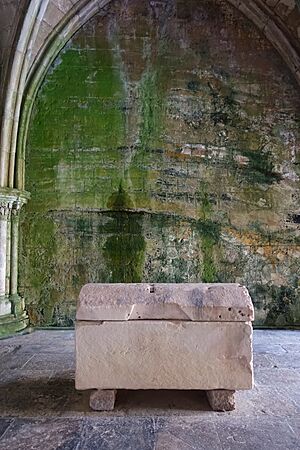Sisnando Davides facts for kids

Sisnando Davides (who died on August 25, 1091) was a brave leader from a group called the Mozarabs. These were Christians who lived under Muslim rule in Spain and Portugal. Sisnando was born in Tentúgal, near Coimbra. He was a military leader during the Reconquista, which was a long period when Christian kingdoms took back land from Muslim rulers. Sisnando knew another famous leader, El Cid, but Sisnando mostly worked in the southwest of the Iberian Peninsula.
We learn a lot about Sisnando from old documents written by his office in Coimbra. However, some people now wonder if all these old papers are completely true.
Contents
Sisnando's Family Life
Sisnando's parents were David and Susana. This is written in old records from the Lorvão Abbey. He was probably born in Tentúgal. He also had two brothers named Zacarías and Mido Davídiz.
Sisnando married a woman named Loba Núñez. Her father was Nuño Méndez, who was the last Count of Portucale. He came from a very old and important family. Sisnando's family was not as well-known. This marriage might have helped create peace between the Mozarabs of Coimbra and the powerful families in northern Portugal.
Loba's father, Count Nuño Méndez, lost his lands. This happened after he was defeated in a battle in 1071 by King García of Galicia. Later, King Alfonso VI gave some of these lands back to Loba and Sisnando.
Sisnando and Loba had one daughter, Elvira Sisnández. She married Martín Muñoz, who was from the Ribadouro family.
In his will, Sisnando left gifts for María, who was the mother of his son, Alfonso Sisnández. We don't know if Alfonso was born within marriage or not.
Working for Kings
Sisnando grew up and was educated in Córdoba, a city ruled by Muslims. He was captured during a raid by Abbad II al-Mu'tadid, the ruler of Seville. Sisnando then started working for him. The Arabs called him Shishnando. He worked for al-Mu'tadid as an administrator and an ambassador. An ambassador is someone who represents their ruler in another place.
Later, Sisnando left Seville and began working for Ferdinand I of León. He did similar jobs for him.
In the years that followed, Christian forces captured many towns in Galicia. These towns stretched from Guimarães down to Coimbra. Coimbra was captured in 1064 or 1069, with Sisnando's help and advice. He led the attack on Coimbra. After his success, he was made the count of the area south of the Douro River, from Lamego to the sea. He called himself the aluazir (which means vizier or high official) de Coimbra.
Sisnando continued to serve Ferdinand's son, King Alfonso VI. In March 1075, Sisnando was with the king and El Cid in Oviedo. They were there for an important event. Later that month, Sisnando helped decide a legal case. He and El Cid were the only ones to sign the final decision. Later that year, Sisnando was a main leader in Alfonso's military trips against Seville and Granada. He also joined a trip against Granada in 1080.
Sisnando was sent by King Alfonso to talk with the rulers of Zaragoza three times (in 1076, 1080, and 1088). He also went to talk with Abdallah ibn Buluggin, the last king of Granada. Sisnando explained to him that the parias (tributes or payments) Alfonso demanded were meant to make them weaker. This was a step before the Christians would try to take over their lands.
Governing Toledo
After the city of Toledo was captured in 1085, Sisnando was chosen as its first governor. He was called an amil. He made sure that King Alfonso's policy of being fair to the Mozarabs (Christians) and Mudéjars (Muslims) in the area was followed. He was probably chosen for this job because he was a Mozarab himself.
Sisnando advised King Alfonso to stay on good terms with al-Qadir of Toledo. He suggested that Alfonso should act as a protector for the city, not someone who interfered too much. But this advice was not followed. This opened the door for the Almoravids, a group from North Africa, to conquer Toledo. The Almoravids then won several more battles against the Castilians. Some historians believe that if King Alfonso had listened to Sisnando, these problems might have been avoided.
Soon after Toledo was captured, Sisnando lost favor with Constance of Burgundy, who was Alfonso's second wife. Her French friends at court, including the new archbishop of Toledo, also did not like Sisnando. Some old writings say that Sisnando tried to convince Alfonso to save the mosque in Toledo. However, it was actually Queen Constance and the new archbishop who turned the mosque into a Christian church.
Within six months of Toledo's capture, Sisnando went back to Coimbra. But he was in Toledo for the special ceremony to dedicate the new cathedral in December. His name appears on the document for this event as Sisnandus Conimbriensis consul (which means "consul of Coimbra"). He had been replaced as governor of Toledo by Pedro Ansúrez.
Ruling Portugal
A new county was created around Coimbra, separate from the northern County of Portugal. Sisnando was chosen to rule it. He didn't have strong ties to northern Spain, so this helped the king have more control over the powerful people in Portugal. It also helped the king's government expand into the newly conquered lands.
Sisnando is first mentioned as ruling in Coimbra on May 1, 1070. However, some people doubt if this document is real. It's possible he was made count later, around 1075, when he first appeared at King Alfonso VI's court. In Portugal, Sisnando built or rebuilt castles in Coimbra, Lousã, Montemor-o-Velho, Penacova, and Penela. He also helped set up a new church area, called a diocese, in Coimbra.
An old legal paper from 1077 calls Sisnando domno de tota Sancta Maria et Colimbria (meaning "lord of all Santa Maria and Coimbra"). In another document from April 25, 1085, Sisnando gave land to Pedro, an abbot who had come to Portugal from a Muslim area. This document calls Sisnando magnum ducem et consulem fidelem domnum Sisenandum (meaning "great duke and faithful consul, lord Sisnando").
Last Battle and Death
On March 15, 1087, Sisnando wrote his will. He did this because he was leaving for a military trip with King Alfonso. They were going to fight against Yusuf ibn Tashfin, a general from the Almoravids.
Sisnando died on August 25, 1091. He had ruled Coimbra for more than twenty years, with a lot of independence. He was buried in the Old Cathedral of Coimbra. His son-in-law, Martín Muñoz, took over after him.
The County of Coimbra stopped being a separate area in 1093. It became part of the Second County of Portugal when it was re-established in 1095 under Henry of Burgundy.
Images for kids
Sources
- Catlos, Brian A. (2004). The Victors and the Vanquished: Christians and Muslims of Catalonia and Aragon, 1050 – 1300. Cambridge Studies in Medieval Life and Thought, Fourth Series, 59. Cambridge: Cambridge University Press. ISBN 0-521-82234-3.
- Reilly, Bernard F. (1989). The Kingdom of León-Castilla under King Alfonso VI, 1065 – 1109. Princeton: Princeton University Press. http://libro.uca.edu/alfonso6/index.htm.
See also
 In Spanish: Sisnando Davídiz para niños
In Spanish: Sisnando Davídiz para niños



